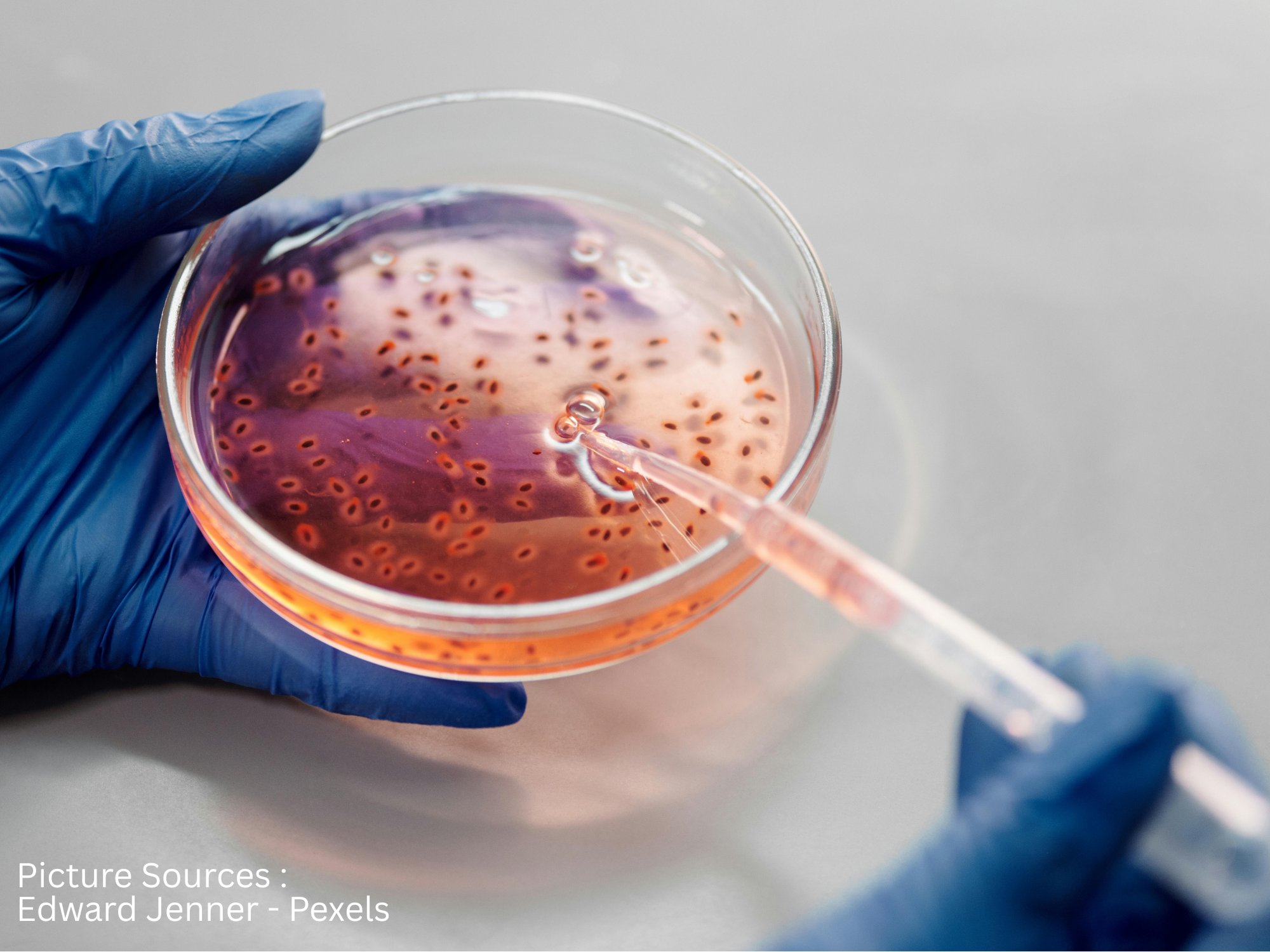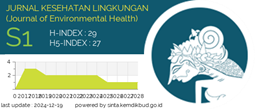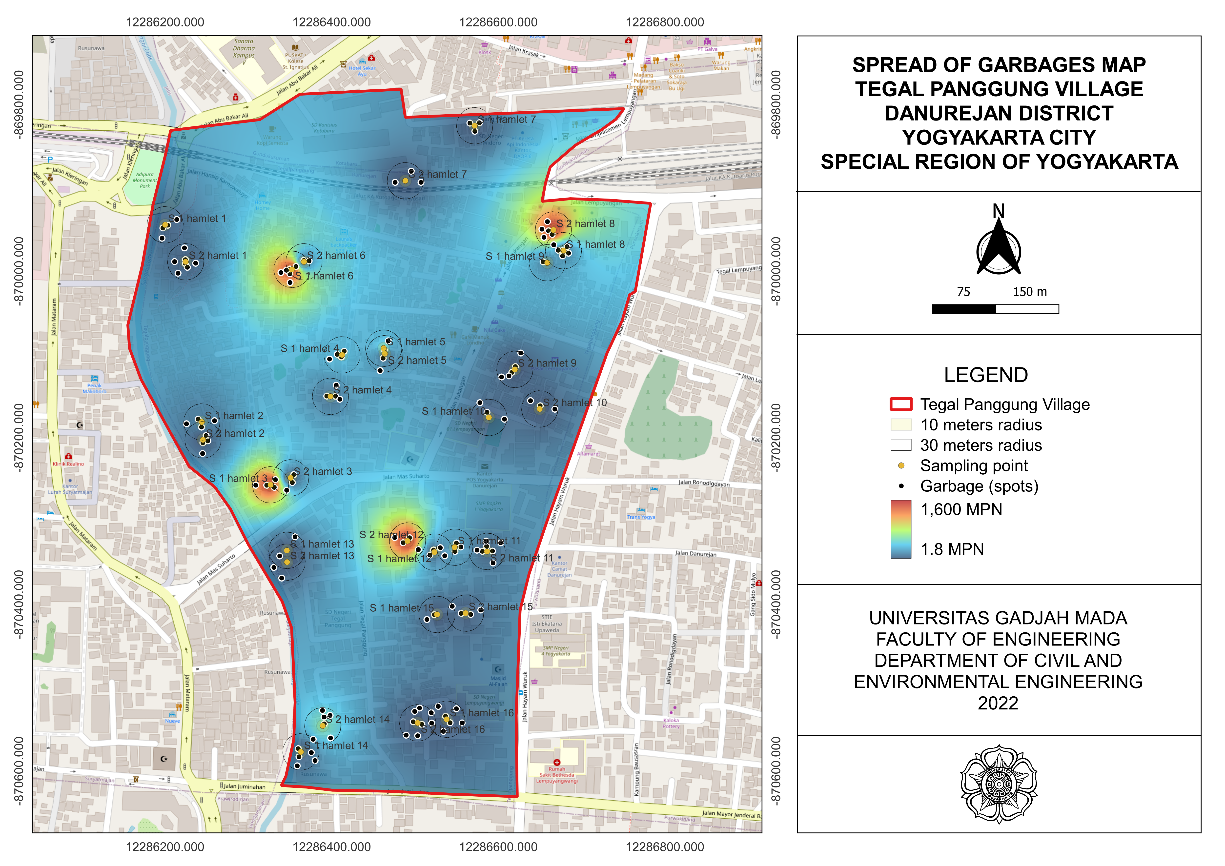Evaluation of Adulticidal Clorine with Black Sand, White Sand and Silica Sand for Decline Coliform Bacteria

Introduction: The World Health Organization estimates that approximately 2.2 billion individuals globally lack access to safely managed drinking water supplies. The development of chlorine diffusers represents a promising intervention to address bacterial contamination, particularly coliform bacteria in water sources. To optimise their efficacy, rigorous analysis of chlorine diffusers’ performance and optimal material combinations is required to ensure a maximum reduction in coliform populations. Methods: The study population comprised all water sources in the Pabelan Kartasura Sukoharjo Village area, with a total sample volume of 720 litres. Subsequently, 100 mL aliquots were collected from each water reservoir using sterilised sampling bottles. Parameters assessed included temperature, pH, total dissolved solids (TDS), and coliform counts. Instrumentation for physicochemical analysis included thermometers, TDS meters, and digital pH meters, while coliform detection was conducted using the Compact Dry EC method. Each sample was evaluated at four time intervals: 0, 30, 45, and 60 minutes. Results and Discussion: Analysis revealed statistically significant differences in coliform bacterial counts among chlorine diffuser types incorporating silica sand, white sand, and black sand. Conversely, no statistically significant variations were observed for temperature, pH, or TDS across the experimental groups. These findings point out the importance of sand composition in enhancing chlorine diffusers’ antimicrobial efficacy. Conclusion: Chlorine diffusers incorporating diverse sand media demonstrated varying efficacy in reducing coliform bacteria, with black sand exhibiting the most pronounced reduction. This finding suggests that material selection significantly influences the functional performance of chlorine-based water disinfection systems.
Adzura M, Fathmawati YY. Hubungan Sanitasi, Air Bersih dan Mencuci Tangan dengan Kejadian Stunting pada Balita di Indonesia. Front Neurosci. 2021;14(1):1–13. https://doi.org/10.32382/sulolipu.v21i1.2098
Adams EA, Adams YJ, Koki C. Water, Sanitation, and Hygiene (WASH) Insecurity will Exacerbate the Toll of COVID-19 on Women and Girls in Low-income Countries. Sustain Sci Pract Policy. 2021;17(1):86–90. https://doi.org/10.1080/15487733.2021.1875682
Nagar A, Pradeep T. Safe Drinking Water through Nanotechnology: Needs, Gaps, and Fulfillment. ACS Nano. 2020;14(6):6420–6435. https://doi.org/10.1021/acsnano.9b01730
Kementerian Kesehatan. Permenkes No. 2 Tahun 2023. Kemenkes Republik Indonesia. 2023;(55):1–175. https://peraturan.bpk.go.id/Download/301587/Permenkes%20Nomor%202%20Tahun%202023.pdf
Kemenkes RI. Profil Kesehatan Indonesia 2021. Pusdatin. Kemenkes.Go.Id. 2022. Kementerian Kesehatan Republik Indonesia. https://kemkes.go.id/app_asset/file_content_download/Profil-Kesehatan-Indonesia-2021.pdf
Ali AS, Gari SR, Goodson ML, Walsh CL, Dessie BK, Ambelu A. The Impact of Wastewater-Irrigated Urban Agriculture on Microbial Quality of Drinking Water at Household Level in Addis Ababa, Ethiopia. Urban Water J. 2023;20(9):1207–1218. https://doi.org/10.1080/1573062X.2023.2253215
Raihani N, Rahayuwati L, Yani DI, Rakhmawati W. Hubungan Ketersediaan Sarana Sanitasi Dasar dengan Kejadian Stunting pada Balita. Journal of Nursing Care. 2023;6(1):35–43. https://doi.org/10.24198/jnc.v6i1.44429
Vaidya R, Kumar KRS, Mohan KMS, Rao L. Chlorine Degradation in Continuous and Intermittent Drinking Water Supply Networks. Urban Water J. 2023;20(1):60–73. https://doi.org/10.1080/1573062X.2022.2139275
Clayton GE, Thorn RMS, Reynolds DM. The Efficacy of Chlorine-Based Disinfectants Against Planktonic and Biofilm Bacteria for Decentralised Point-Of-Use Drinking Water. NPJ Safe Drinking Water. 2021;4(1):1-8. https://doi.org/10.1038/s41545-021-00139-w
Harris JD, Homola LMJ, You AE, Smith JA. Enhancing Microbial Disinfection in Household Water Treatment by Combining a Silver–Ceramic Tablet with Copper and Chlorine Technologies. J Environ Eng. 2024;150(7):402-410. https://doi.org/10.1061/JOEEDU.EEENG-7555
Grath MJ, Maleki M, Bouchard C, Pelletier G, Rodriguez MJ. Bulk and Pipe Wall Chlorine Degradation Kinetics in Three Water Distribution Systems. Urban Water J. 2021;18(7):512–521. https://doi.org/10.1080/1573062X.2021.1893368
Monteiro L, Carneiro J, Covas DIC. Modelling Chlorine Wall Decay in A Full-Scale Water Supply System. Urban Water J. 2020;17(8):754–762. https://doi.org/10.1080/1573062X.2020.1804595
Fisher I, Kastl G, Sathasivan A. Validity of Chlorine-Wall Reaction Models for Drinking Water Distribution Systems. Urban Water J. 2023;20(9):57–68. https://doi.org/10.1080/1573062X.2023.2241437
Solomon ET, Robele S, Kloos H, Mengistie B. Effect of Household Water Treatment with Chlorine on Diarrhea Among Children Under the Age of Five Years in Rural Areas of Dire Dawa, Eastern Ethiopia: A Cluster Randomized Controlled Trial. Infect Dis Poverty. 2020;9(1):1–13. https://doi.org/10.1186/s40249-020-00680-9
Prihambodo B, Wildan FYA, Prayoga E, Jaffar A. Klasifikasi Kualitas Air Sungai Berbasis Teknik Data Mining dengan Metode K-Nearest Neighbor (K-NN). Emit J Tek Elektro. 2023;1(1):31–36. https://doi.org/10.23917/emitor.v1i1.20833
Macedo DO, Janzen JG. Modelling the Behaviour of Chlorine Within A Drinking Water Distribution System Following A Microbial Contamination Event. Urban Water J. 2022;19(5):531–537. https://doi.org/10.1080/1573062X.2022.2030370
Zhang J, Li W, Zhang X, Wang X, Lv L. Combined Applications of UV and Chlorine on Antibiotic Resistance Control: A Critical Review. Environ Res. 2024;243(117884):1-12. https://doi.org/10.1016/j.envres.2023.117884
Genter F, Putri GL, Handayani R, Priadi C, Willetts J, Fosfer T. Evaluation of A Participatory Citizen Approach to Monitor Microbial Water Quality of Self-Supply in Urban Indonesia. Urban Water J. 2024;21(3):272–284. https://doi.org/10.1080/1573062X.2023.2285438
Bonkoungou IJO, Somda NS, Traore O, Zoma BS, Garba Z, Drabo KM. Detection of Diarrheagenic Escherichia Coli in Human Diarrheic Stool and Drinking Water Samples in Ouagadougou, Burkina Faso. Heart. 2021;15(1):53–58. https://doi.org/10.21010/ajid.v15i1.7
Alif N, Anna DNS, Cholil M, Priyana Y, Fikriyah VN, Rudiyanto. Peningkatan Pengetahuan Masyarakat untuk Pengelolaan Air Secara Berkelanjutandi Desa Pucangan Kabupaten Sukoharjo. J Pengabdi UNDIKMA. 2024;5(1):56–64. https://doi.org/10.33394/jpu.v5i1.6571
Maran AA, Arnawa IGP. Efisiensi Penurunan Kandungan Angka Kesadahan Total , Eschericia Coli , Kekeruhan Air Sumur Gali Melalui Pengolahan Koagulasi dan Filtrasi dengan Metode Single Media , Dual Media dan Mixed Media di Kota Kupang Ta. Indones J Public Heal. 2024;2(1):93–101. https://jurnal.academiacenter.org/index.php/IJOH/article/view/297
Puspitasari DZ, Astuti D, Porusia M. Personal Hygiene Penjamah Makanan pada Industri. J Kesehat. 2023;16(1):51–63. https://doi.org/10.23917/jk.v16i1.19767
Porusia M, Asyfiradayati R, Ratna S, Putri S, Dwinanda S. Comparison of Microbiological Quality of Well Water and Contaminated River Water in Open Defecation Area. Atlantis Press. 2021; 22(49):95–100. https://doi.org/10.2991/ahsr.k.220403.013
Putri DY, Indah S, Helard D. Bacteriological Contamination of Groundwater Affected by Septic Tanks Condition in Koto Tangah District, Padang, Indonesia. J Kesehatan Lingkungan. 2022;14(3):163–170. https://doi.org/10.20473/jkl.v14i3.2022.163-170
Asyfiradayati R, Alam W, Sriwahyuni E, Hadiana F. Uji Bakteriologis Air Bersih Pemukiman Sekitar Mata Air Cokro Desa Krajan Kabupaten Klaten. Jurnal Ners. 2023;7:1407–1412. https://doi.org/10.31004/jn.v7i2.17177
Rizal AM, Asyfiradayati R. Differences in the Reduction of Coliform Bacteria and Escherichia Coli with the Chlorine Diffuser Method Combined with Silica Sand in Safe Drinking Water. Sci Midwifery. 2024;12(3):1-9. https://doi.org/10.35335/midwifery.v12i3.1632
Behzadi B, Noei M, Azimi A, Mirzaei M, Anaraki AH. Experimental Optimization of the Disinfection Performance of Sodium Hypochlorite and Hypochlorous Acid in Pilot and Industrial Cooling Towers. Iran J Oil Gas Sci Technology. 2021;10(2):1–11. https://doi.org/10.22050/ijogst.2021.265594.1578
Yantu SS, Warouw F, Umboh JML. Hubungan Antara Sarana Air Bersih dan Jamban Keluarga dengan Kejadian Diare pada Balita di Desa Waleure. J KESMAS. 2021;10(6):24–30. https://ejournal.unsrat.ac.id/v3/index.php/kesmas/article/view/35445
Saputri N, Astuti YP. Hubungan Faktor Lingkungan dengan Kejadian Diare pada Balita di Puskesmas Bernung. J Ilmu Keperawatan dan Kebidanan. 2019;10(1):101–110. https://doi.org/10.26751/jikk.v10i1.619
Fibrianti EA, Thohari I, Marlik M. Hubungan Sarana Sanitasi Dasar dengan Kejadian Stunting di Puseksmas Loceret, Nganjuk. J Kesehatan. 2021;14(2):127–132. https://doi.org/10.32763/juke.v14i2.339
Meehan K, Jurjevich JR, Chun NMJW, Sherrill J. Geographies of Insecure Water Access and The Housing–Water Nexus in US Cities. Proc Natl Acad Sci USA. 2020;117(46):287–297. https://doi.org/10.1073/pnas.2007361117
Hafidzna HA, Anna AN. Analisis Spasial Kandungan Bakteri Coliform Pada Air Tanah Dangkal di Kecamatan Colomadu Kabupaten Karanganyar. Universitas Muhammadiyah Surakarta; 2021. http://eprints.ums.ac.id/id/eprint/93402
Azteria V, Rosya E. Drinking Water Quality of Water Refill Station in Gebang Raya Tanggerang. J Kesehatan Lingkungan. 2023;15(2):120–126. https://doi.org/10.20473/jkl.v15i2.2023.120-126
Wei Y, Wu H, Zhang X, Liang Y, Shi D, Wang L. Comparative Analysis of Chlorine-Resistant Bacteria After Chlorination and Chloramination in Drinking Water Treatment Plants. J Hazard Mater. 2024;469(3):134-145. https://doi.org/10.1016/j.jhazmat.2024.134075
WHO. Guidelines for Drinking-Water Quality: Incorporating the First and Second Addenda. World Health Organization. 2022. 1–14. https://www.who.int/publications/i/item/9789240045064
Kwio-Tamale JC, Onyutha C. Influence of Physical and Water Quality Parameters on Residual Chlorine Decay in Water Distribution Network. Heliyon. 2024;10(e30892):23-30. https://doi.org/10.1016/j.heliyon.2024.e30892
Marchesi I, Paduano S, Frezza G, Sircana L, Vecchi E, Zuccarello P. Safety and Effectiveness of Monochloramine Treatment for Disinfecting Hospital Water Networks. J Environ Res Public Health. 2020; 20(17)17-26. https://doi.org/10.3390/ijerph17176116
Saputri ET, Efendy M. Kepadatan Bakteri Coliform Sebagai Indikator Pencemaran Biologis di Perairan Pesisir Sepuluh Kabupaten Bangkalan. Jurnal Ilmu Kelautan dan Perikanan. 2020;1(2):243–249. https://doi.org/10.21107/juvenil.v1i2.7579
DeLuca V, Carginale V, Supuran CT, Capasso C. The Gram-Negative Bacterium Escherichia Coli as A Model for Testing the Effect of Carbonic Anhydrase Inhibition on Bacterial Growth. J Enzyme Inhib Med Chem. 2022;37(1):2092–2098. https://doi.org/10.1080/14756366.2022.2101644
García-Ávila F, Valdiviezo-Gonzales L, Cadme-Galabay M, Gutiérrez-Ortega H, Altamirano-Cárdenas L, Arévalo CZ. Considerations on Water Quality and the Use of Chlorine in Times Of Sars-Cov-2 (Covid-19) Pandemic in The Community. Case Study Chemical and Environmental Engineering. 2020;2(100049):1-10. https://doi.org/10.1016/j.cscee.2020.100049
Guo K, Wu Z, Chen C, Fang J. UV/Chlorine Process: An Efficient Advanced Oxidation Process with Multiple Radicals and Functions in Water Treatment. Acc Chem Res. 2022; 55(3):286–297. https://doi.org/10.1021/acs.accounts.1c00269
Fish KE, Reeves-McLaren N, Husband S, Boxall J. Unchartered Waters: The Unintended Impacts of Residual Chlorine on Water Quality and Biofilms. NPJ Biofilms Microbiomes. 2020;6(1):1–12. https://doi.org/10.1038/s41522-020-00144-w
Atrashkevich A, Alum A, Stirling R, Abbaszadegan M, Garcia-Segura S. Approaching Easy Water Disinfection for All: Can in Situ Electrochlorination Outperform Conventional Chlorination Under Realistic Conditions?. Water Res. 2024;250(121014):1-11. https://doi.org/10.1016/j.watres.2023.121014

This work is licensed under a Creative Commons Attribution-NonCommercial-ShareAlike 4.0 International License.
1. Copyright of all journal manuscripts is held by the Jurnal Kesehatan Lingkungan.2. Formal legal provisions to access digital articles of electronic journal are subject to the provision of the Creative Commons Attribution-ShareAlike license (CC BY-NC-SA), which means that Jurnal Kesehatan Lingkungan is rightful to keep, transfer media/format, manage in the form of databases, maintain, and publish articles.
3. Published manuscripts both printed and electronic are open access for educational, research, and library purposes. Additionally, the editorial board is not responsible for any violations of copyright law.
JKESLING by UNAIR is licensed under a Creative Commons Attribution-ShareAlike 4.0 International License.







































